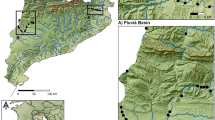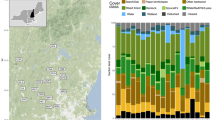Abstract
Three species of nectar-feeding bats migrate from tropical and subtropical Mexico into the Sonoran and Chihuahuan deserts during the spring and summer months. We examined geographic and seasonal changes in the diet of one migrant species, Leptonycteris curasoae, using carbon stable isotope techniques to determine the relative importance of C3 and CAM (Cactaceae, Agavaceae) plants in its diet. We also examined the diet of a non-migratory nectar-feeding bat, Glossophaga soricina, from southern Mexico using the same techniques. We found that L. curasoae feeds extensively or exclusively on CAM plants during migration and in the northern part of its range and feeds mostly on C3 plants in southern Mexico. This bat is a year-round resident on Baja California where it is a CAM specialist. The non-migrant G. soricina feeds mostly on C3 plants year-round. Phenological data suggest that certain species of columnar cacti and at least one group of paniculate Agaves on the Mexican mainland provide a spatio-temporally predictable nectar corridor along which nectarivorous bats may migrate in the spring and fall, respectively. Different flowering schedules of Agaves in Baja California appear to promote year-round dietary specialization and perhaps non-migratory behavior in nectar-feeding bats living there.
Similar content being viewed by others
References
Alvarez T, Gonzalez QL (1970) Analisis polinico del contenido gastrico de murcielagos Glossophaginae de Mexico. An. Escuela Nac Cienc Biol 18:137–165
Barbour RW, Davis WH (1969) Bats of America. University of Kentucky Press, Lexington, Kentucky
Bender MM (1971) Variations in 13C/12C ratios of plants in relation to the pathway of carbon dioxide fixation. Phytochemistry 10:1239–1244
Brown JH, Kodric-Brown A (1979) Convergence, competition, and mimicry in a temperate community of hummingbird-pollinated flowers. Ecology 60:1022–1035
Cockrum EL (1991) Seasonal distribution of northwestern populations of the long-nosed bats, Leptonycteris sanborni Family Phyllostomidae. Anal Instit Biol Univ Nac Auton Mexico Ser Zool 62:181–202
DeNiro MJ, Epstein S (1978) Influence of diet on the distribution of carbon isotopes in animals. Geochim Cosmochim Acta 42:495–506
Fleming TH (1992) How do fruit-and nectar-feeding birds and mammals track their food resources? In: Hunter MD, Ohgushi T, Price PW (eds) Effects of resource distribution on plantanimal interactions. Academic Press, Orlando, Florida, pp 355–391
Gardner AL (1977) Food habits. In: Baker RJ, Jones Jr. JK, Carter DC (eds) Biology of bats of the New World family Phyllostomidae, part 1. Spec. Publ. Museum Texas Tech Univ. No. 13:293–350
Gentry HS (1982) Agaves of continental North America. University of Arizona Press, Tucson, Arizona
Grant KA, Grant V (1968) Hummingbirds and their flowers. Columbia University Press, New York, New York
Heithaus ER, Fleming TH, Opler PA (1975) Foraging patterns and resource utilization in seven species of bats in a seasonal tropical forest. Ecology 56:841–854
Howell DJ (1979) Flock foraging in nectar-feeding bats: advantages to the bats and to the host plants. Am Nat 114:23–49
Howell DJ, Roth BS (1981) Sexual reproduction in agaves: the benefits of bats; the cost of semelparous advertising. Ecology 62:1–7
Osmond CB, Allaway WG, Sutton BG, Troughton JH, Queiroz O, Luttge U, Winter K (1973) Carbon isotope discrimination in photosynthesis of CAM plants. Nature (London) 246:41–42
Quiroz DL, Xelhuatzi MS, Zamora MC (1986) Analisis palinologico del contenido gastrointestinal de los murcielagos Glossophaga soricina y Leptonycteris yerabuenae de las Grutas de Juxtlahuaca, Guerrero. Instit Nac Antrop Histor Serie Prehistoria, 1–62
Tieszen LL, Boutton TW, Tesdahl KG, Slade NA (1983) Fractionation and turnover of stable carbon isotopes in animal tissues: implications for δ 13C analysis of diet. Oecologia 57:32–37
Waser NM, Real LA (1979) Effective mutualism between sequentially flowering plant species. Nature (London) 281:670–672
Wiggins IL (1980) Flora of Baja California. Stanford University Press, Stanford, California
WoloszynD, WoloszynBW (1982) Los mammiferos de la Sierra de la Laguna, Baja California Sur. CONACYT, Mexico
Author information
Authors and Affiliations
Rights and permissions
About this article
Cite this article
Fleming, T.H., Nuñez, R.A. & Sternberg, L.d.S.L. Seasonal changes in the diets of migrant and non-migrant nectarivorous bats as revealed by carbon stable isotope analysis. Oecologia 94, 72–75 (1993). https://doi.org/10.1007/BF00317304
Received:
Accepted:
Issue Date:
DOI: https://doi.org/10.1007/BF00317304




